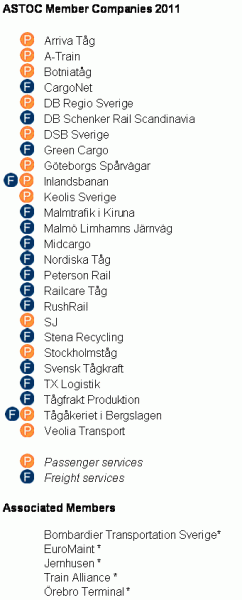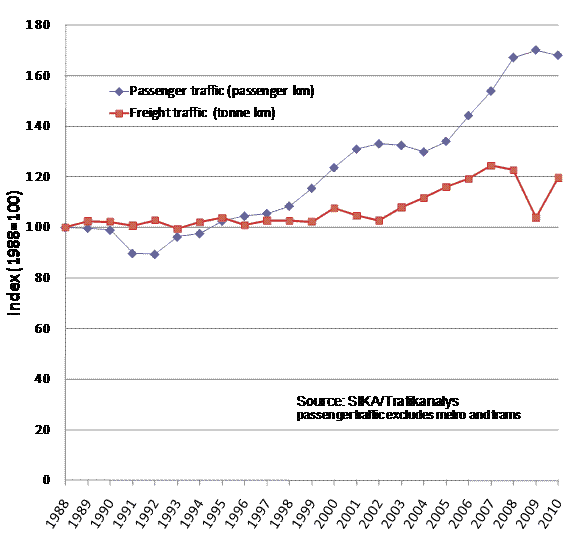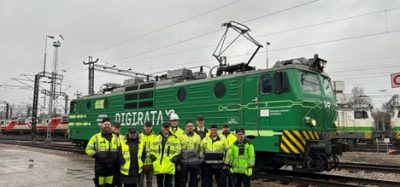Growth in member numbers helps strengthen the work of ASTOC
Posted: 22 September 2011 | | No comments yet
The Association of Swedish Train Operating Companies (ASTOC) acts on behalf of Sweden’s train operators. It seeks to represent the interests of commercial rail traffic in its dealing with the Government and Parliament, authorities, business principals, the media and other bodies. ASTOC also assists in increasing the rail industry’s know-how and competitiveness by providing information, advice and services to members. During 2010–2011, several topics have attracted the interest and work of ASTOC, not least related to the latest developments of Swedish transport policy.
ASTOC has continued to grow in terms of the number of members. The association now has 26 members (up from 21 from the previous year) of train operating companies carrying either passengers or freight (see Figure 1). In addition to this, the number of associated members has increased from two to five. A major new member is Malmtrafik AB (MTAB), the train operating subsidiary to the mining and ore company giant LKAB, based in Kiruna in the very north of Sweden. It is a company with unique competence in heavy-load freight traffic, also used to face rather extreme weather conditions. In recent years, the booming demand for raw materials such as iron has implied a surge in volumes from the mining industry – to be transported by rail as well as by other modes. LKAB is currently struggling to keep up with demand.
The Association of Swedish Train Operating Companies (ASTOC) acts on behalf of Sweden’s train operators. It seeks to represent the interests of commercial rail traffic in its dealing with the Government and Parliament, authorities, business principals, the media and other bodies. ASTOC also assists in increasing the rail industry’s know-how and competitiveness by providing information, advice and services to members. During 2010–2011, several topics have attracted the interest and work of ASTOC, not least related to the latest developments of Swedish transport policy. ASTOC has continued to grow in terms of the number of members. The association now has 26 members (up from 21 from the previous year) of train operating companies carrying either passengers or freight (see Figure 1). In addition to this, the number of associated members has increased from two to five. A major new member is Malmtrafik AB (MTAB), the train operating subsidiary to the mining and ore company giant LKAB, based in Kiruna in the very north of Sweden. It is a company with unique competence in heavy-load freight traffic, also used to face rather extreme weather conditions. In recent years, the booming demand for raw materials such as iron has implied a surge in volumes from the mining industry – to be transported by rail as well as by other modes. LKAB is currently struggling to keep up with demand.
The Association of Swedish Train Operating Companies (ASTOC) acts on behalf of Sweden’s train operators. It seeks to represent the interests of commercial rail traffic in its dealing with the Government and Parliament, authorities, business principals, the media and other bodies. ASTOC also assists in increasing the rail industry’s know-how and competitiveness by providing information, advice and services to members. During 2010–2011, several topics have attracted the interest and work of ASTOC, not least related to the latest developments of Swedish transport policy.
ASTOC has continued to grow in terms of the number of members. The association now has 26 members (up from 21 from the previous year) of train operating companies carrying either passengers or freight (see Figure 1). In addition to this, the number of associated members has increased from two to five. A major new member is Malmtrafik AB (MTAB), the train operating subsidiary to the mining and ore company giant LKAB, based in Kiruna in the very north of Sweden. It is a company with unique competence in heavy-load freight traffic, also used to face rather extreme weather conditions. In recent years, the booming demand for raw materials such as iron has implied a surge in volumes from the mining industry – to be transported by rail as well as by other modes. LKAB is currently struggling to keep up with demand.


Figure 1 ASTOC members
In other places in Sweden, price hikes have even sparked a renewed interest in old mines that have been closed for decades. If this trend continues, the forecasted increase in volumes will pose a tremendous challenge to the railway system. Several new minor operators have also joined ASTOC recently. Among the associated members, Bombardier Transportation is one of the prominent additions. As ASTOC’s CEO Peder Wadman puts it: “We are delighted to welcome all these new members. They represent all parts of today’s many-faceted Swedish railway industry, where both small and large companies find new business opportunities.”
During 2010, freight volumes carried by rail increased substantially, almost bouncing back to the level they enjoyed before the sudden collapse in the fall of 2008, which was closely linked to the financial crisis (see Figure 2). Passenger services were never really hit by the crisis but declined somewhat in 2010, mainly because of the problems caused by the severe winter (windy and snowy), affecting both the beginning and the end of the year. For 2011, the first six months show an increase in demand for both passenger and freight services.


Figure 2 Development of passenger and freight traffic in Sweden 1988-2010
In 2010 and 2011, it has become increasingly clear that the Swedish rail infrastructure is not in a good shape and will have problems to meet the demand of the future. The current 12-year plan for maintenance, reinvestments and new investments (decided upon as recently as last spring) will not be sufficient. Following an intense political debate and recurrent coverage of all kinds of rail-related problems in the media, the government decided to let Trafikverket (the Swedish Transport Administration, formed by means of the 2010 merger of the road and rail administrations) take a closer look at what can be done in both the near-, mid- and long-term to improve the railway system. Focus is on capacity but also on how to stop the current network from degrading further. A preliminary report was published in July, to be followed by a final version in October covering the near- and mid-term. A long-term view will be presented in February 2012. In early July, ASTOC arranged a seminar in Visby, Gotland, where the head of this work at Trafikverket, Deputy General Director Mrs. Lena Erixon, presented the results so far. This was followed by a debate (moderated by ASTOC Chairman Mr. Jan Sundling) including the Minister of Infra – structure, Mrs. Catharina Elmsäter-Svärd, and several CEOs from the industry.
Trafikverket has reached the conclusion that the plan approved in 2010 was based on old forecasts of demand that have already been surpassed. This means that the wear and tear of the Swedish rail infrastructure has accelerated in recent years. Unless more money is directed towards maintenance and reinvestments, traffic volumes actually have to be capped or even reduced in order to uphold a robust level of performance. In order to keep the current supply of traffic or make it possible to increase the capacity to meet future demand, an additional 14.5 to 38.3 billion SEK are needed for the planning period ending in 2021. Some of this may be financed by means of rationalisations within Trafikverket (an ongoing work) and increased track access charges, but it is clear that more state grants are also needed. In the fall we will see if the current right-centre-liberal government (no longer backed by a clear majority in Parliament) will try to tackle this problem already in its budget for 2012.
In August 2010, the new Botnia Line was put in operation. This line serves the double purpose of addressing a growing demand for freight services with very ambitious plans to build a new regional network of passenger services in the Northern parts of Sweden. This is also the first line in Sweden which has been equipped with ERTMS (level 2) from the start, making it an important line for testing how ERTMS works in practice. For the new passenger services, a new joint venture between SJ and DB was chosen as the contractor following a tender. Unfortunately, this traffic, as well as other services, has been affected by a number of technical-related problems. Most of these refer to the infra – structure but some also to the vehicles and the ETCS equipment onboard. It is clear that not enough time was given to test the line and the vehicles before actual operations started. Furthermore, the abundance of problems has highlighted a need to address the continued roll-out of ERTMS in Sweden. ASTOC has been supportive to ERTMS in the past – and still is – but believes that there is a need to carefully consider the risks associated with the roll-out. On some of the very densely trafficked main lines, even minor disturbances can have tremendous implications. Naturally, Sweden has to respect its legal commitment to ERTMS, but the implementation must be done in a sensible way. ERTMS probably needs to be tested further in order to achieve a level of robustness that will not jeopardise the supply of reliable rail services for both passengers and freight customers. Moreover, there is still the problem that minor freight operators (and possibly some big ones too) will never find it profitable to equip their current fleet of vehicles with ETCS due to the steep costs.
In December 2011, the first new timetable following all the recent regulatory changes related to market-opening will take effect. Thereby, the new deregulated environment for domestic passenger rail services (with open access) will be accomplished. In the spring of 2011, Trafikverket received the first applications from train operating companies making use of the new competitive environment. Veolia, which has been a pioneer in this respect and already runs daily trains between Stockholm and Malmö in competition with SJ, will expand its services northbound to the city of Uppsala. An airline expressed interest in running trains in parallel to its current flights between Stockholm and Sundsvall (also in competition with SJ). However, this application was withdrawn later due to a lack of access to appropriate vehicles. A new up-start company intends to compete with SJ on the flag-ship line between Stockholm and Gothenburg. In addition to all this, SJ has chosen to apply for a continuation of most of its current services, while some of the county public transport authorities have ambitious plans to expand. All-in-all, this means that, looking just at the applications, more passenger services will be offered in 2012 than today. This again highlights the need to have sufficient capacity available on the railway network, as well as a decent way to distribute this capacity in case of conflicting demands. This is still very much an ongoing process. Another observation is that several of the operators already present in the Swedish market seem to be a bit cautious for now, with further actions dependent upon how the market unfolds in terms of capacity constraints and the availability of rolling stock. Some companies have stated that they will focus on their contracted services for the time being.
In 2012, we will see another important change in the regulatory landscape as it will then also become possible to compete directly (on a commercial basis) with services provided by the county public transport authorities. This may primarily affect local and regional bus services but can also have an impact on rail.
ASTOC continues to follow the develop – ment of European Union transport policy, primarily through its membership in the Community of European Railways and Infrastructure Companies (CER). The new Transport Policy White Paper (or Road Map) from the Commission includes short-term plans for further market-opening of domestic passenger services in the EU. ASTOC believes that recent and current experience from Sweden in this area should be monitored and analysed in order to develop a reasonable framework for the European Union.
About the Author
Dr. Gunnar Alexandersson is a Senior Policy Adviser at the Association of Swedish Train Operating Companies (ASTOC). He is also involved in some research projects at Stockholm School of Economics. His PhD thesis on regulatory reforms and market opening in the Swedish bus and railway sectors was finalised in 2010. For a period in 2007–2008, he worked as Senior Economics Policy Adviser at the Community of European Railways and Infrastructure Companies (CER) in Brussels.
Issue
Related topics
Related organisations
The Association of Swedish Train Operating Companies (ASTOC)







